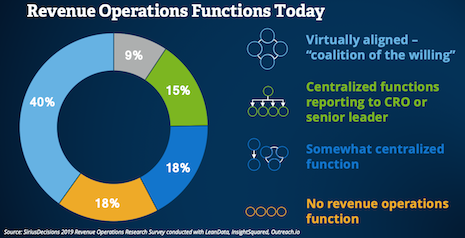- About
- Subscribe Now
- New York,
October 7, 2019

 Rise of revenue ops: Opportunity or threat to marketing leaders? Image credit: SiriusDecisions
Rise of revenue ops: Opportunity or threat to marketing leaders? Image credit: SiriusDecisions
By Megan Heuer
“Change is the law of life. And those who look only to the past or present are certain to miss the future.” – John F. Kennedy
We are at a moment of great change and opportunity for business-to-business. As Carly Simon’s “Anticipation” goes, “These are the good old days.”
We have rapid technology innovation, positive culture change, loads of creativity and sustained business growth in many sectors.
Even better, we finally have broad agreement that the remits of B2B sales, marketing and product functions must now include both the pre- and post-sale customer experience to support growth and retention goals.
My worry is that because of fear, some leaders – especially chief marketing officers – will miss the window to benefit from all this opportunity.
Optics
It is a shame to let fear prevent progress, so I would like to set the record straight on a key trend that is causing concern: the rise of revenue operations and what this means for chief marketing officers (CMOs).
First, let us talk about how we define revenue operations.
Revenue operations is made up of sales operations, marketing operations and customer success operations teams that work together in accordance with a set of operating principles that align planning, processes, technology, data and measurement that help organizations maximize revenue and performance.
In other words, the concept of revenue operations is a natural extension of what we have supported since its inception: Organizations that align their revenue engine pre- and post-sale grow faster and more profitably than those that are not aligned.
Revenue operations makes alignment easier by defining a clear set of accountabilities and actions, then formalizing the elements that expand the potential for alignment to succeed.
Spoiler alert: I believe that building a holistic revenue engine that includes aligned revenue operations will be a positive game changer for B2B CMOs. I base this assertion on current evidence and our knowledge of how best to optimize the B2B revenue engine.
The goal of revenue operations is to reap the benefits of alignment for customers and the overall revenue engine.
The goal is not to combine all ops functions into one, to create a new function or upend organizational design, or to somehow reduce the role of sales or marketing. It is simply to get our act together once and for all around alignment and shared resources, starting with a very logical place: operations.
But let us not get ahead of ourselves.
Today, revenue ops is an emerging strategy, and there is more than one way to set it up.
Revved up?
The SiriusDecisions’ 2019 Revenue Operations Research Survey, conducted with LeanData, InsightSquared and Outreach.io, showed that deployment models for revenue operations range from a loose coalition of teams to virtually aligned functions to centralized functions, as you can see in the chart called "Revenue Operations Functions Today." (Nine percent of organizations – indicated by the gray segment in the chart – reported they have a revenue ops function but cannot describe it.)
Because we are still learning about what works best and because every organization has its own constraints, we do not need to declare any one approach the right one.
Instead, we will focus on how to determine the best way to allow the functions that revenue ops covers to formalize accountability for alignment pre- and post-sale, and to define what shared technology and data are needed to make it work.
This enables sales, marketing and customer success to define their best contributions to customer experience and revenue growth – and have the efficient operational foundation to deliver on them.
Unfortunately, we continue to see a great deal of trepidation among marketing leaders who believe revenue operations is the death knell of all they have done to win respect and a seat at the leadership table.
Some marketing leaders tell us that when they hear about revenue operations or that their organization wants to hire a chief revenue officer (CRO), they are immediately concerned that the CRO will come from sales and instantly ruin all the good marketing has done.
And let us be honest: They are not wrong to have some of these concerns.
In a worst-practice deployment of revenue operations – for example, under an unenlightened CRO with no knowledge of marketing – devaluation could happen. This would be a huge mistake.
The absolute wrong way to interpret revenue ops is that it means getting rid of marketing operations, putting everything under sales operations, removing the CMO or reducing the CMO’s span of leadership, and having marketing report to a CRO who comes from sales and has no idea what marketing can do.
It also does not mean focusing on the pre-sale areas of operations and leaving out customer success. This is a recipe for disaster.
The good news is that it is also not the most likely outcome.
In 2019, with all the progress that we have made, so many of us – sales and marketing leaders alike – know better and have no desire to go back to those bad old days.
 Revenue operations functions today. Source: SiriusDecisions’ 2019 Revenue Operations Research Survey conducted with LeanData, InsightSquared and Outreach.io
Revenue operations functions today. Source: SiriusDecisions’ 2019 Revenue Operations Research Survey conducted with LeanData, InsightSquared and Outreach.io
Instead, smart organizations are looking at revenue operations and an aligned revenue engine as a way for marketing to continue its rise in importance and contribution to growth.
MO
So much has changed to earn CMOs a solid position on leadership teams. Most organizations that deploy revenue ops correctly view this move as a way to enhance their commitment to becoming customer obsessed.
These organizations’ leaders believe revenue ops allows sales, marketing and customer success to plan together, measure together, and build a shared view of customer and prospect data that enables more integrated systems to deliver more valuable insights and support effective execution.
The results of our study showed that when they executed it well, organizations that deployed revenue ops in some form grew revenue nearly three times faster than those that did not.
Public companies with revenue ops also had 71 percent higher stock performance. These findings further prove that alignment is the key to building a revenue engine focused at once on customer needs and the organization’s growth goals. Why, then, are so many marketing leaders so concerned about what revenue ops means for their role and the level of respect and authority for marketing within their organization?
A CMO’s job gets better when revenue ops is done right.
Let us get past our fear of repeating mistakes by not allowing them to happen again as we deploy revenue operations.
The path has some risk of being hijacked by an approach led inordinately by sales.
Our study showed that in 46 percent of organizations in which revenue operations is a centralized function, that function reports to a CRO. Twenty-four percent of those organizations indicated that it reports to a centralized operations leader (e.g. chief operating officer).
Marketing is the function least managed by CROs, who are 2.9 times more likely to manage sales than marketing and 1.6 times more likely to manage sales than customer success.
This data suggests that today, revenue operations most likely is not living up to its full potential because marketing is not part of the team.
SO, HERE IS my challenge to marketing leaders.
As the saying goes, “Be the change you wish to see in the world.”
Fear should not cause you to dismiss the potential of revenue operations to enhance marketing’s contribution and amplify its impact on business growth and the customer experience.
Revenue ops will not take away your seat at the table. It will give you a better one – but only if you show up and do not let anxiety hold you back. Are you with us?
 Megan Heuer is vice president of research at the SiriusDecisions product line by Forrester
Megan Heuer is vice president of research at the SiriusDecisions product line by Forrester
Megan Heuer is vice president of research at the SiriusDecisions product line by Forrester. This article originally appeared here.
Share your thoughts. Click here